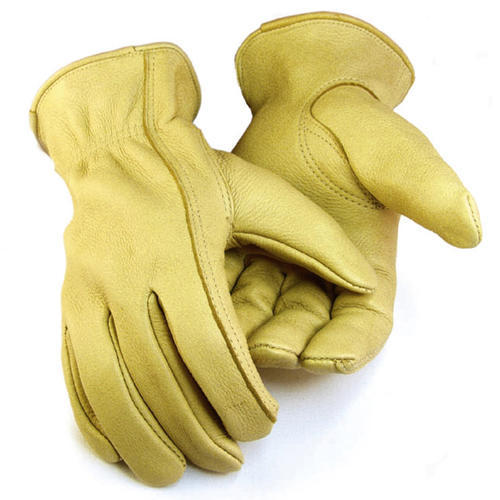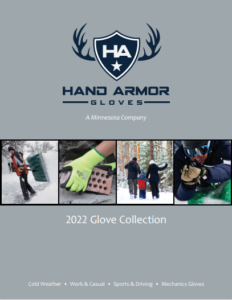Work Gloves In 5 Easy Steps

Breaking the Code: How to Choose a Leather Work Glove in Five Easy Steps
Grain or split leather? Clute or Gunn cut? Safety or gauntlet cuff? Lined or unlined?
The wide variety of choices in leather work gloves means that there is almost always “the perfect” one for any given application – finding that glove, however, may not always seem so easy. By understanding the differences between available features, you can narrow the playing field and make an educated decision!
Step 1: Types of Leather
Leather is made from the tanned hides of various animals. Leather quality varies because it is a natural product. The most common types of leather used for work gloves are shown below:
- Cow : The most common and popular type of leather used for gloves. Creates a moderately priced, comfortable, durable glove with excellent abrasion resistance. It is warmer than pig or goatskin, and more heat resistant.
- Pig : Offers the greatest breathability due to the porous texture of the hide. Becomes softer with use and withstands moisture without becoming stiff. Can be laundered without losing its shape or function.
- Deer : Soft, more comfortable, longer wearing and more flexible than cowhide. Sometimes called “buckskin.” It is the warmest of leathers.
- Goat : The strongest and most durable type of leather. The natural lanolin in the skin makes the glove very supple, waterproof and abrasion resistant. Excellent for tasks involving fine dexterity.
Full or Top Grain Leather comes from the external side of the hide and is typically smooth, although it can be lightly sanded or processed after tanning to feel like suede or velvet. It is the most durable type of leather and offers good dexterity.
- Leather cut from the sides and shoulder of the animal offers the greatest durability.
- Belly and neck cuts are less durable, and are often used for “economy grade” gloves and trims.
Split leather or suede comes from the underside of the hide, has no natural grain, and is not as strong as grain leather. The area from which the glove is cut determines durability and dexterity.
- Belly split leather is the most economical, but it is not consistent in texture or appearance. It is the least durable.
- Shoulder split leather is economical, but less durable than side split leather because the additional movement in the shoulder area creates less dense fibers and more visible differences in texture.
- Side split comes from the rib area. It is very durable and consistent with dense fibers. Of split leathers, this is the best quality.
For greatest longevity, choose grain leather gloves. For temporary workers or sporadic, incidental jobs, split leathers will likely “do the job” and offer a greater cost savings.
Step Two: Patterns
The way a glove is cut helps determine the dexterity and comfort that the glove will afford.
- Gunn Cut pattern features a single-piece, seamless back with fine seams set away from the working area of the palm. The two middle fingers are sewn separately into the palm to help minimize bulk in those fingers, increasing dexterity. This design provides better wear and greater comfort. The design also minimizes stress on the glove for longer wear, and provides natural gripping action for handling tools.
- Clute Cut pattern has a one-piece palm with no seam at the base of the fingers and a straight thumb. Seams are along the inside of each finger. The design gives the glove a roomier fit, and makes it more economical than gloves requiring more sewn seams.
Workers who are handling large boxes or bales of product don’t typically need the tactile sensitivity that a contractor hammering finishing nails or a worker sorting small pieces does.
Step Three: Thumb Design
Sometimes, a seemingly small detail like thumb design can make a big difference in the comfort or functionality of a glove that is worn all day.
- Straight thumbs are designed for non-rigorous activities. They are the least effective because they do not allow for natural thumb motion. Because they require little stitching, they are the most economical style.
- Wing thumbs have an angled construction that allows for greater flexibility and efficiency than straight thumbs. They are good for pushing and pulling applications and when gloves are worn for greater periods of time. Wing thumbs are often found on mid-priced gloves.
- Keystone thumbs offer superior movement and overall comfort. They are ideal for applications where there is extreme wear in the thumb webbing area, such as pulling wires or handling small pipes. Because they require the most sewing, they are the most expensive thumb option.
Step Four: Cuffs
Application plays a large role in choosing a cuff design. Cuffs can add warmth, help prevent abrasion from particles falling into the glove, increase safety by doffing when caught in a machine, or allowing for sleeves to be tucked.
Step Five: Linings
Although they are traditionally added for warmth, linings can also help make gloves more comfortable for long-term wear.
- Cotton and jersey linings help prevent chaffing.
- Wool and pile linings hold up longer and are warmer than cotton or jersey linings.
- Thinsulate® and similar “thermal” linings are available in several different weights to help insulate hands against cold temperatures.
Story Courtesy of NewPig

